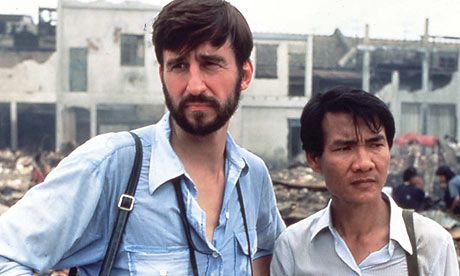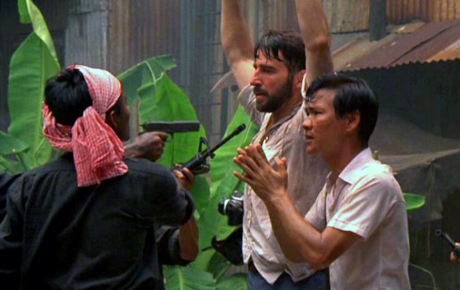|
|
Reviewed by Glenn Erickson
Some of the catastrophic genocidal massacres of the second half of the twentieth century have already been all but forgotten. Even after the awful lessons of the Holocaust, mass political murders of the kind that happened in East Timor in 1975, were almost completely ignored by the western press. In terms of the American culture, the Far East has traditionally been considered a place where "life is cheap", an attitude that didn't sit well when Americans were involved in military actions in places like the Philippines. Nixon's widening of the Vietnam War into Cambodia and Laos led to the 1975 rise of the Khmer Rouge in Cambodia. In an insane revolution, the cities were emptied and sent to rural labor camps; the clock was turned back to, "Year Zero". Calling the new dictatorship Kampuchea, Khmer Rouge leader Pol Pot instituted a program of outright genocide, arresting and executing monks, intellectuals, teachers, even people who understood a foreign language or had ties to the outside world. In the space of a three years, it is estimated that 2.5 million Cambodians were killed. Many of their remains were left in enormous burial spaces that came to be known as killing fields.
It's a big, horrible story, and not the kind of thing considered viable as motion picture entertainment. It began as a 1980 New York Times story by Sydney Schanberg, a reporter who had been ejected from Cambodia when the Khmer Rouge took over, along with the rest of the foreign press. Schanberg's local assistant, and a reporter in his own right, was Dith Pran. Their bond of loyalty and one bad decision led to the abandonment of Pran to the mercy of the Pol Pot regime. Pran spent years in hellish re-education camps, hiding his identity and education while watching fanatic child-soldiers routinely slaughter other prisoners. Back in New York, Sydney Schanberg held out hope that the resourceful Pran might have survived. He felt guilty receiving journalistic awards while the wife and children that Pran should have left with had already given him up for dead.

On a roll with his popular and celebrated films Chariots of Fire and Midnight Express, producer David Puttnam engaged actor Bruce Robinson to write the screenplay and British TV veteran Roland Joffé to direct. Their film The Killing Fields has an unconventional structure. The first half builds the relationship between Sydney Schanberg and Pran. Sam Waterston gives what is probably his best performance as the conscientious reporter who defies the efforts of the American Major Reeves (Craig T. Nelson) to cover up U.S. military actions within Cambodia's borders. To play Dith Pranh, the producers found Dr. Haing S. Ngor, a Cambodian who barely survived his own imprisonment in a Khmer re-education camp. Just the year before, director Peter Weir had used the stunt casting of the diminutive Linda Hunt to play a similar 'reporter's helper' in the drama The Year of Living Dangerously. Dr. Ngor comes off as the genuine article, a clever and dedicated Cambodian who can translate freely between the local language, English and French.
The Killing Fields conveys an exciting, suspenseful impression of what it must have been like to be working in Phnom Pehn, at the center of a war zone. With Pran's help, Sydney maneuvers around the lies and misdirection of the U.S. Consul (monologist Spalding Gray). The journalistic partners bribe a boatman to take them to a U.S.-bombed town deemed off limits by the Army, which conducts its own sanitized jaunt for 'cooperative' foreign journalists. Two years later, when Pol Pot's rebels enter the capitol, Sydney and Pran are still making excuses to avoid leaving. Pran uses prayer, bribery and quick thinking to save Sydney, reporter John Swain (Julian Sands) and their photographer friend Al Rockoff (John Malkovich) from summary execution on the street. They're eventually trapped in the French embassy. All Cambodians are ordered to leave, so Swain and Rockoff try desperately to mock up a fake passport identifying Pran as a foreigner. But none of their efforts are successful.

Commercial pressures spoil many mainstream films about social problems in the Third World. Richard Attenborough's well-intentioned Cry Freedom! (1987) references the story of the murder of Steve Biko, an anti-Apartheid activist. Yet the movie is really about the struggle of a white journalist against the South African regime. In the second half of The Killing Fields, American Schanberg makes an exit, and Dith Pran's survival story comes front and center. Instead of a noble martyr or a Gunga Din- like sidekick, Pran is an intelligent man trying to survive against all odds in a nation gone politically insane. The Khmer Rouge is forcing the entire country back to an agrarian existence. Because children have no decadent experiences to expunge, specially indoctrinated teenagers enforce the ruthless New Order. Pran eventually becomes a servant to a camp commander, who is himself concerned that he will fall out of favor and be executed. Pran dotes on the commander's son, and through the child is given a chance to flee for the border. His journey is like a struggle through Hell -- at one juncture Pran must half-crawl, half-swim through rice fields crowded with rotting corpses.
Filmed in Thailand, The Killing Fields is a harrowing ordeal from one end to the other, held together by the warm bond between its reporter colleagues. Screenwriter Robinson avoids outright cynicism, and neither does it attempt to implicate the viewer in the atrocities on screen. In the middle '70s most Americans were happy that the Vietnam experience was finished and didn't want to hear any more bad news from Southeast Asia. Horrible events like the genocide in Cambodia turned out to be the real 'domino effect' of the Vietnam War.

To its credit, the production sees no need to hype events for the benefit of the audience. The makers of the recent Argo decided that its true reportage of diplomatic personnel trapped in a revolution wasn't exciting enough, and cheapened the movie with an old-fashioned suspense sequence. The Killing Fields has more respect for its subject matter.
The Killing Fields was nominated for seven Academy Awards and took home three: for Haing S. Ngor as Best Supporting Actor, Chris Menges' cinematography and the editing of Jim Clark. The big hit Amadeus prevailed in the other categories. Spalding Gray's participation during the shoot became the subject of his one-man monologue film, Swimming to Cambodia.
Warner Home Video's Blu-ray of The Killing Fields is a handsome HD encoding of this meticulously made and photographed modern epic. Director Roland Joffés commentary is a big plus. The original trailer promises an important movie without coming off as pompous. Warner's book-style packaging contains an illustrated souvenir booklet. First-time viewers will discover that the story of Sydney Schanberg and Dith Pran is accurately portrayed.
On a scale of Excellent, Good, Fair, and Poor,
The Killing Fields Blu-ray rates:
Movie: Excellent
Video: Excellent
Sound: Excellent
Supplements: Commentary, trailer, souvenir booklet
Deaf and Hearing-impaired Friendly?
YES; Subtitles: English, French, Spanish
Packaging: Keep case
Reviewed: January 8, 2014
Republished by permission of Turner Classic Movies.

DVD Savant Text © Copyright 2014 Glenn Erickson
See more exclusive reviews on the Savant Main Page.
The version of this review on the Savant main site has additional images, footnotes and credits information, and may be updated and annotated with reader input and graphics.
Return to Top of Page
|

